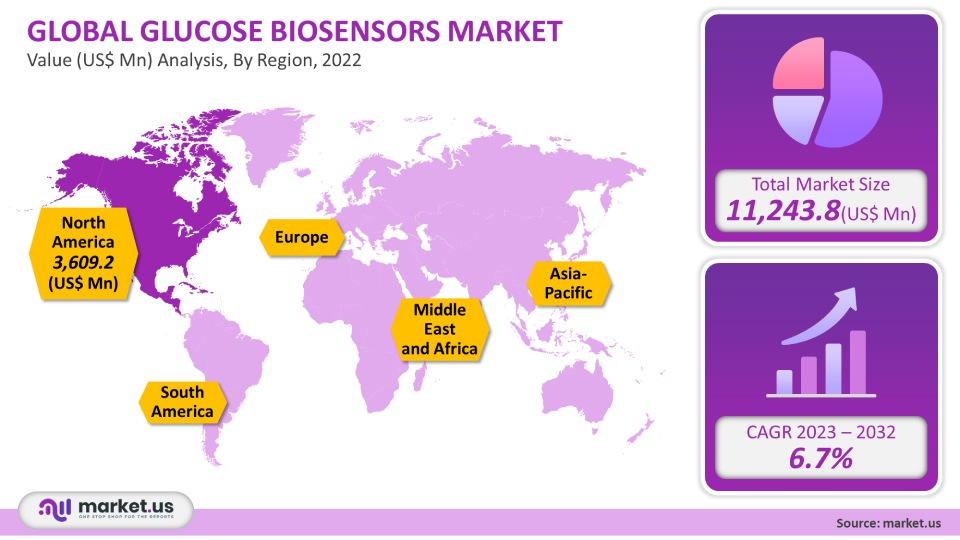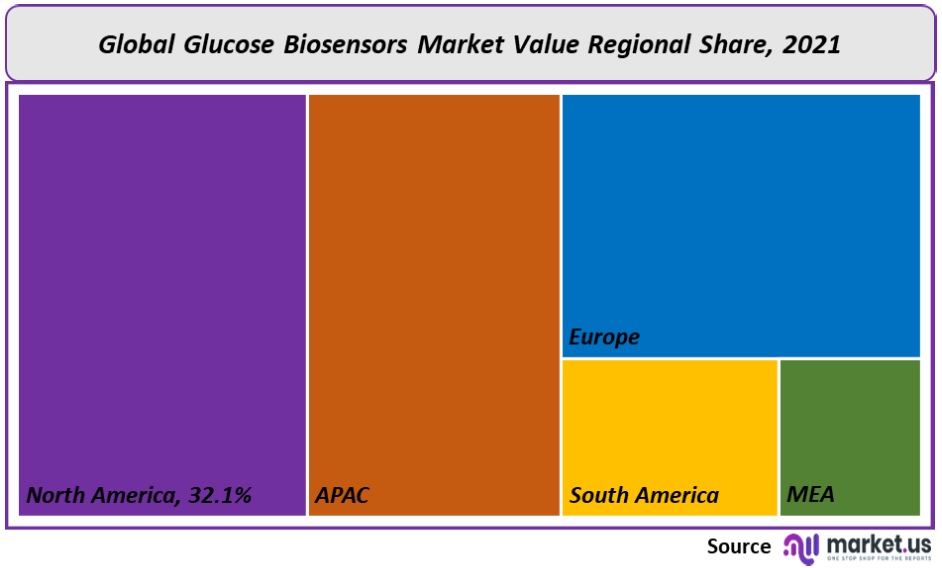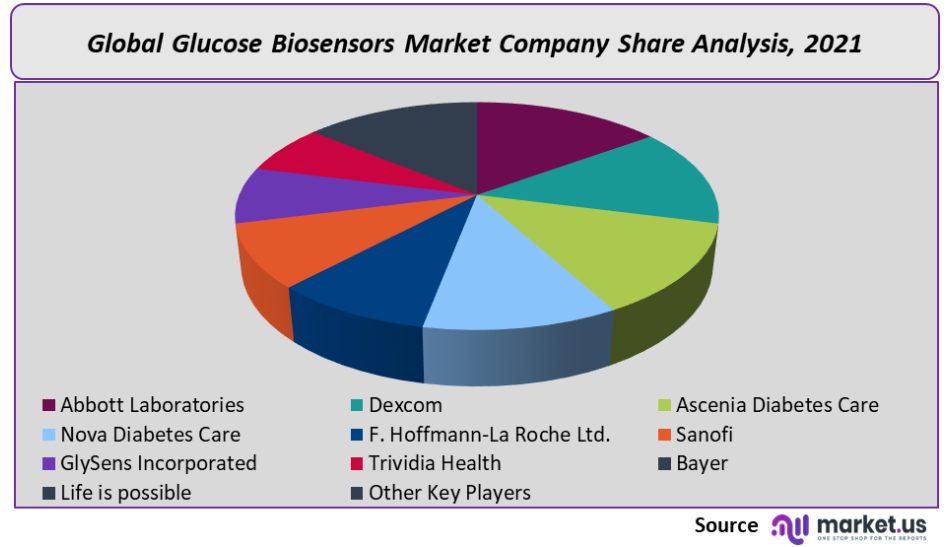Global Glucose Biosensors Market By Type (Electrochemical Biosensor, Optical Biosensor, and Other Types), By End-Use (Homecare, Hospitals, and Diagnostic centers), By Region and Companies - Industry Segment Outlook, Market Assessment, Competition Scenario, Trends and Forecast 2022-2032
- Published date: Mar 2022
- Report ID: 20907
- Number of Pages: 326
- Format:
- keyboard_arrow_up
Glucose Biosensors Market Overview
The global Glucose Biosensors Market was valued at USD 11,243.8 million in 2021. It is expected to grow at 6.7% CAGR during the forecast period. Market growth is expected to be driven by the growing adoption of small-sized, non-invasive glucose monitoring systems and the rising incidence of diabetes worldwide. The International Diabetes Federation estimated that 537 million people would be diagnosed with diabetes in 2021. The market will also grow due to increased patient awareness and early detection of diabetes. To avoid complications, diabetic patients must monitor their blood glucose levels.
Global Glucose Biosensors Market Analysis
Type Analysis
In 2021, the electrochemical biosensor segment held the largest market share at more than 57.2%. It is expected to maintain its dominance over the forecast period due to its high sensitivity, reproducibility, and ease of use. Electrochemical biosensors are based on an enzyme catalytic reaction, which either produces or consumes electrons. The electrochemical glucose biosensors allow for simple, one-step glucose testing. They also fulfill the requirements of personal home glucose testing. The segment of optical biosensors is expected to grow at 7.3% over the forecast period. Fiber optics detect optical glucose biosensors using absorption, illumination, and light scattering or refraction principles. This includes fluorescence, absorptiometry (SPR), and fluorescence. Optical biosensors offer many advantages over traditional testing methods, including remote sensing, electrical interference-free operation, and a rapid reaction time. These sensors do have some drawbacks. They can be interfered with by light sources and require high-energy light sources.

End-Use Analysis
Due to improvements in infrastructure and increased healthcare spending in hospitals, the segment had the highest revenue share at more than half of the total in 2021. The FDA approved home-use glucose meters for hospitals during the COVID-19 pandemic. These devices are simple to use and provide quick results that greatly improve hospital workflows and patient care. Hospitals are expected to be driven by patients’ desire for quick, easy, and stress-free glucose biosensors.
Due to the growing demand for home care services in developed and developing countries, the home care segment will see the most growth. Advanced technologies allow patients to monitor their glucose levels quickly without needing a clinic setting. This allows them to evaluate the effects of their treatment, such as nutrition, exercise, and stress management, based on what they see.
Key Market Segments
By Type
- Electrochemical biosensor
- Optical biosensor
- Other Types
By End-use
- Homecare
- Hospitals
- Diagnostic centers
Market Dynamics
Glucose sensors are essential for diabetes management and can be used to monitor blood glucose levels. A glucose biosensor that is reliable, sensitive, accurate, and reliable is crucial. Growing demand for self-monitoring devices has led to increased use of glucose biosensors by diabetic patients. These devices can be used in home and outpatient settings to measure glucose levels.
Technology advancements will play an important role in increasing usage rates. The market has seen the introduction of glucose biosensors that are non-invasive and minimally invasive. Numerous companies, large and small, invest in extensive R&D to create more reliable, painless, cost-effective, accurate, and reliable products. Abbott, for example, launched the Libre Sense Glucose Sports Biosensor in 2020. This glucose sensor is intended to aid athletes in understanding the relationship between glucose levels and athletic performance.
The COVID-19 Pandemic has opened up new opportunities for glucose biosensors in the diabetic care industry. Because of the emphasis on telemedicine and virtual clinics for diabetes management, consumers are now more aware of the many benefits of blood glucose monitoring devices. Patients and healthcare professionals could improve glycemic control and perhaps increase patient self-management. This led to a significant shift in diabetes care. Patients still suffered from economic setbacks.
Regional Analysis
North America was the dominant market in 2021, with a 32.1% market share. This is due to the rising prevalence of diabetes in North America. The market growth is expected to be driven by the rising geriatric population and the increasing burden of diabetes from lifestyle changes, preference for remote monitoring at home, and technological advances in the region. Asia-Pacific is expected to experience rapid growth over the forecast period. Market growth is driven by improvements in healthcare facilities, reimbursement policies, and other factors. Market growth is also expected to be driven by improvements in healthcare facilities and reimbursement policies.

Key Regions and Countries covered in thе rероrt:
- North America
- US
- Canada
- Mexico
- Europe
- Germany
- UK
- France
- Italy
- Russia
- Spain
- Rest of Europe
- APAC
- China
- Japan
- South Korea
- India
- Rest of Asia-Pacific
- South America
- Brazil
- Argentina
- Rest of South America
- MEA
- GCC
- South Africa
- Israel
- Rest of MEA
Market Share & Key Players Analysis:
Major players are working hard to enhance their product offerings. They also take advantage of significant cooperation activities and explore acquisitions and government clearances to increase their customer base and capture a greater share of the overall market. Medtronic announced in 2020 that the U.S. FDA approved its Android Guardian Connect CGM system. The Guardian Connect is a standalone CGM system that notifies patients 60 minutes before any high or low sensor glucose events. Listed below are some of the most prominent players in the market for glucose biosensors:

Маrkеt Кеу Рlауеrѕ:
- Abbott Laboratories
- Dexcom
- Ascenia Diabetes Care
- Nova Diabetes Care
- Hoffmann-La Roche Ltd.
- Sanofi
- GlySens Incorporated
- Trividia Health
- Bayer
- Life is possible
- Other Key Players
For the Glucose Biosensors Market research study, the following years have been considered to estimate the market size:
Attribute Report Details Historical Years
2016-2020
Base Year
2021
Estimated Year
2022
Short Term Projection Year
2028
Projected Year
2023
Long Term Projection Year
2032
Report Coverage
Competitive Landscape, Revenue analysis, Company Share Analysis, Manufacturers Analysis, Volume by Manufacturers, Key Segments, Key company analysis, Market Trends, Distribution Channel, Market Dynamics, COVID-19 Impact Analysis, strategy for existing players to grab maximum market share, and more.
Regional Scope
North America, Europe, Asia-Pacific, South America, Middle East & Africa
Country Scope
United States, Canada and Mexico, Germany, France, UK, Russia and Italy, China, Japan, Korea, India and Southeast Asia, Brazil, Argentina, Colombia etc.Saudi Arabia, UAE, Egypt, Nigeria and South Africa
Frequently Asked Questions (FAQ)
What is the size of the glucose biosensors Market in 2021?The glucose biosensors Market size is US$ 11,243.8 million in 2021.
What is the projected CAGR at which the glucose biosensors Market is expected to grow at?The glucose biosensors Market is expected to grow at a CAGR of 6.7% (2023-2032).
List the segments encompassed in this report on the glucose biosensors Market?Market.US has segmented the glucose biosensors Market by geographic (North America, Europe, APAC, South America, and Middle East and Africa). By Type, the market has been further divided into Electrochemical biosensor, Optical biosensor, and Other Types. By End-use, the market has been further divided into Homecare, Hospitals, and Diagnostic centers.
List the key industry players of the glucose biosensors Market?Abbott Laboratories, Dexcom, Ascenia Diabetes Care, Nova Diabetes Care, F. Hoffmann-La Roche Ltd., Sanofi, GlySens Incorporated, Trividia Health, Bayer, Life is possible, and Other Key Players engaged in the Glucose Biosensors Market.
Which region is more appealing for vendors employed in the glucose biosensors Market?North America is expected to account for the highest revenue share of 32.1%. Therefore, the glucose biosensors industry in North America is expected to garner significant business opportunities over the forecast period.
Name the key areas of business for glucose biosensors?The US, India, China, Canada, UK, Japan, & Germany are key areas of operation for the glucose biosensors Market.
Which segment accounts for the greatest market share in the glucose biosensors industry?With respect to the glucose biosensors industry, vendors can expect to leverage greater prospective business opportunities through the electrochemical biosensor segment, as this area of interest accounts for the largest market share.
![Glucose Biosensors Market Glucose Biosensors Market]()
- Abbott Laboratories
- Dexcom
- Ascenia Diabetes Care
- Nova Diabetes Care
- Hoffmann-La Roche Ltd.
- Sanofi Company Profile
- GlySens Incorporated
- Trividia Health
- Bayer AG Company Profile
- Life is possible
- Other Key Players
- settingsSettings
Our Clients
|
Single User
$5,999
$2,999
USD / per unit
save 50% |
Multi User
$7,999
$3,499
USD / per unit
save 55% |
Corporate User
$12,999
$4,499
USD / per unit
save 65% | |
|---|---|---|---|
| e-Access | |||
| Data Set (Excel) | |||
| Company Profile Library Access | |||
| Interactive Dashboard | |||
| Free Custumization | No | up to 10 hrs work | up to 30 hrs work |
| Accessibility | 1 User | 2-5 User | Unlimited |
| Analyst Support | up to 20 hrs | up to 40 hrs | up to 50 hrs |
| Benefit | Up to 20% off on next purchase | Up to 25% off on next purchase | Up to 30% off on next purchase |
| Buy Now ($ 2,999) | Buy Now ($ 3,499) | Buy Now ($ 4,499) |









